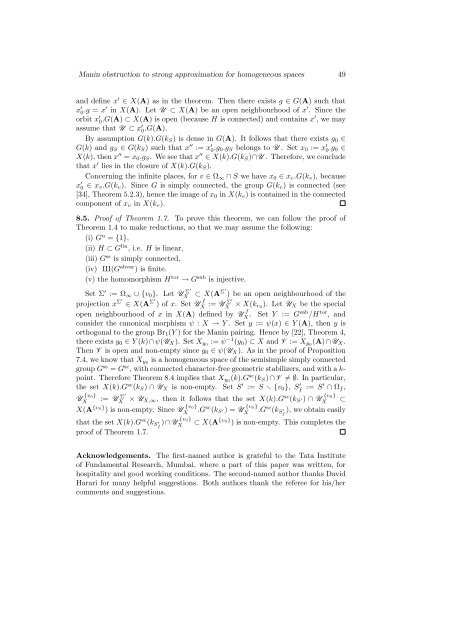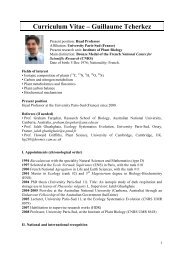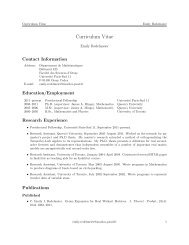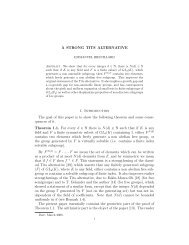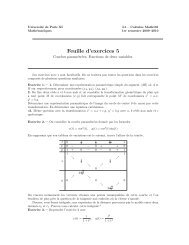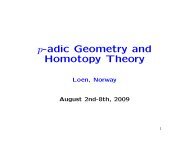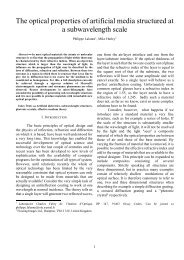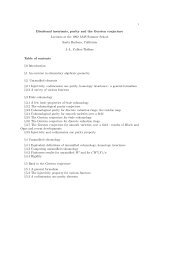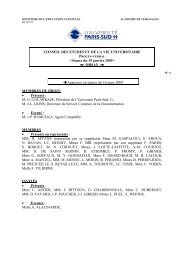Manin obstruction to strong approximation for homogeneous spaces
Manin obstruction to strong approximation for homogeneous spaces
Manin obstruction to strong approximation for homogeneous spaces
You also want an ePaper? Increase the reach of your titles
YUMPU automatically turns print PDFs into web optimized ePapers that Google loves.
<<strong>strong</strong>>Manin</<strong>strong</strong>> <<strong>strong</strong>>obstruction</<strong>strong</strong>> <<strong>strong</strong>>to</<strong>strong</strong>> <strong>strong</strong> <strong>approximation</strong> <strong>for</strong> <strong>homogeneous</strong> <strong>spaces</strong> 49and define x ′ ∈ X(A) as in the theorem. Then there exists g ∈ G(A) such thatx ′ 0.g = x ′ in X(A). Let U ⊂ X(A) be an open neighbourhood of x ′ . Since theorbit x ′ 0.G(A) ⊂ X(A) is open (because H is connected) and contains x ′ , we mayassume that U ⊂ x ′ 0.G(A).By assumption G(k).G(k S ) is dense in G(A). It follows that there exists g 0 ∈G(k) and g S ∈ G(k S ) such that x ′′ := x ′ 0.g 0 .g S belongs <<strong>strong</strong>>to</<strong>strong</strong>> U . Set x 0 := x ′ 0.g 0 ∈X(k), then x ′′ = x 0 .g S . We see that x ′′ ∈ X(k).G(k S )∩U . There<strong>for</strong>e, we concludethat x ′ lies in the closure of X(k).G(k S ).Concerning the infinite places, <strong>for</strong> v ∈ Ω ∞ ∩ S we have x 0 ∈ x v .G(k v ), becausex ′ 0 ∈ x v .G(k v ). Since G is simply connected, the group G(k v ) is connected (see[34], Theorem 5.2.3), hence the image of x 0 in X(k v ) is contained in the connectedcomponent of x v in X(k v ).8.5. Proof of Theorem 1.7. To prove this theorem, we can follow the proof ofTheorem 1.4 <<strong>strong</strong>>to</<strong>strong</strong>> make reductions, so that we may assume the following:(i) G u = {1},(ii) H ⊂ G lin , i.e. H is linear,(iii) G ss is simply connected,(iv) X(G abvar ) is finite.(v) the homomorphism H <<strong>strong</strong>>to</<strong>strong</strong>>r → G sab is injective.Set Σ ′ := Ω ∞ ∪ {v 0 }. Let UXΣ′ ⊂ X(AΣ′ ) be an open neighbourhood of theprojection x Σ′ ∈ X(A Σ′ ) of x. Set U f Σ′X:= UX× X(k v 0). Let U X be the specialopen neighbourhood of x in X(A) defined by U f X . Set Y := Gsab /H <<strong>strong</strong>>to</<strong>strong</strong>>r , andconsider the canonical morphism ψ : X → Y . Set y := ψ(x) ∈ Y (A), then y isorthogonal <<strong>strong</strong>>to</<strong>strong</strong>> the group Br 1 (Y ) <strong>for</strong> the <<strong>strong</strong>>Manin</<strong>strong</strong>> pairing. Hence by [22], Theorem 4,there exists y 0 ∈ Y (k)∩ψ(U X ). Set X y0 := ψ −1 (y 0 ) ⊂ X and V := X y0 (A)∩U X .Then V is open and non-empty since y 0 ∈ ψ(U X ). As in the proof of Proposition7.4, we know that X y0 is a <strong>homogeneous</strong> space of the semisimple simply connectedgroup G ss = G sc , with connected character-free geometric stabilizers, and with a k-point. There<strong>for</strong>e Theorem 8.4 implies that X y0 (k).G sc (k S ) ∩ V ≠ ∅. In particular,the set X(k).G sc (k S ) ∩ U X is non-empty. Set S ′ := S {v 0 }, Sf ′ := S′ ∩ Ω f ,U {v0}X:= UXΣ′× U X,∞, then it follows that the set X(k).G sc (k S ′) ∩ U {v0}X⊂.Gsc (k S ′f), we obtain easilyX(A {v0} ) is non-empty. Since U {v0}Xthat the set X(k).G sc (k S ′f) ∩ U {v0}Xproof of Theorem 1.7..Gsc (k S ′) = U {v0}X⊂ X(A {v0} ) is non-empty. This completes theAcknowledgements. The first-named author is grateful <<strong>strong</strong>>to</<strong>strong</strong>> the Tata Instituteof Fundamental Research, Mumbai, where a part of this paper was written, <strong>for</strong>hospitality and good working conditions. The second-named author thanks DavidHarari <strong>for</strong> many helpful suggestions. Both authors thank the referee <strong>for</strong> his/hercomments and suggestions.


